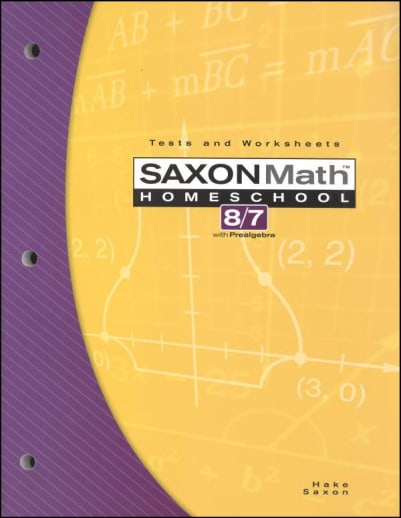Saxon Math 8/7 Homeschool Tests and Worksheets (3rd Edition)
SKU
024437
ISBN
9781591413240
Grade 7-8
Neutral
Low Teacher Involvement
Multi-Sensory
Other Materials Required
Spiral
These icons are designed to help you quickly understand and learn important information about our products.
Teaching Method
Traditional
Teacher-centered curriculum commonly used in classrooms that may include a text, teacher manual, tests, etc.
Charlotte Mason
A methodology based on the work of a 19th century educator who maintained that children learn best from literature (Living Books), not textbooks.
Classical
A methodology based on the Latin Trivium (three stages of learning), including the grammar stage (memorization and facts), logic stage (critical thinking), and rhetoric stage (developing/defending ideas).
Unit Study
A thematic or topical approach centered around one topic that integrates multiple subject areas.
Montessori (Discovery)
A methodology based on the work of a 20th century educator that emphasizes student and sensory-driven discovery learning and real-life applications.
Other
Other methodologies
Religious Content
Secular
Contains content contrary to common Christian beliefs (i.e. evolution).
Neutral
Avoids religious or theoretical topics or presents multiple viewpoints without preference.
Christian/Religious
Faith-based or including instructional religious content.
Learning Modality
Auditory
Learns through listening, talking out loud or reading out loud.
Visual
Learns through seeing, prefers written instructions and visual materials.
Kinesthetic/Tactile (Hands-On)
Learns through moving, doing and touching.
Multi-Sensory
Curriculum that employ a variety of activities/components.
Presentation
Sequential
Curriculum progresses through well-defined learning objectives. Emphasizes mastery before moving to the next topic.
Spiral
Topics and concepts are repeated from level to level, adding more depth at each pass and connecting with review.
Conceptual/Topical
Focus is on the “why,” often with a unifying concept as well as specific skills; coverage may be broader.
Teacher Involvement
Low Teacher Involvement
Student-led materials; parent acts as a facilitator.
Medium Teacher Involvement
A mix of teacher-led time and independent student work.
High Teacher Involvement
Teacher-led lessons; may utilize discussions, hands-on activities and working together.
Additional Materials Required
No other materials needed
Everything you need is included.
Other Materials Required
There are additional required resources that are a separate purchase.
Other Materials Optional
There are additional resources mentioned or recommended but are not absolutely necessary.
Consumable
Consumable
Designed to be written in; not reusable.
Non-Consumable
Not designed to be written in; reusable.
Our Price
$100.07 $100.07 $36.95
Rainbow Savings: $63.12
Description
Tests and Worksheets include a significant amount of fact drill practice, course tests as well as various forms for recording student progress.
Publisher's Description of Saxon Math 8/7 Homeschool Tests and Worksheets (3rd Edition)
Presents materials in manageable lessons with frequent checkpoints, differentiated activities, and engaging practice options.
Category Description for Saxon Math 8/7 (3rd Ed.)
What's covered in this level: For use by seventh graders who have completed Saxon 7/6 or who have
placed into Saxon 8/7. Fractions, decimals, percents, geometry, area, volume, ratio, proportion, exponents, scientific notation, signed numbers,
algebraic terms, 2-step equations and inequalities, slope, graphing, the
Pythagorean Theorem. If students finish this course and have mastered
the last 40 lessons (scoring 90% or higher on tests), they can skip Saxon
Algebra ½ and go into Saxon Algebra 1.
Middle School Homeschool Kits contain a non-consumable Student Edition (textbook), consumable Tests and Worksheets for one student, and a Solutions Manual. Tests and Worksheets also include fact drill practice, course tests, and activity sheets to use with Investigation lessons, and various other forms.
Middle School Homeschool Kits contain a non-consumable Student Edition (textbook), consumable Tests and Worksheets for one student, and a Solutions Manual. Tests and Worksheets also include fact drill practice, course tests, and activity sheets to use with Investigation lessons, and various other forms.
Details
| Product Format: | Paperback Book |
|---|---|
| Grades: | 7-8 |
| Brand: | Saxon Publishers |
| ISBN: | 9781591413240 |
| Length in Inches: | 11 |
| Width in Inches: | 8.5 |
| Height in Inches: | 0.5 |
| Weight in Pounds: | 0.9625 |
| Edition: | 3rd Edition; Revised; Illustrated |
| Pages: | 240 |
| Publication Date: | 4/4/2013 |
Videos
Reviews

